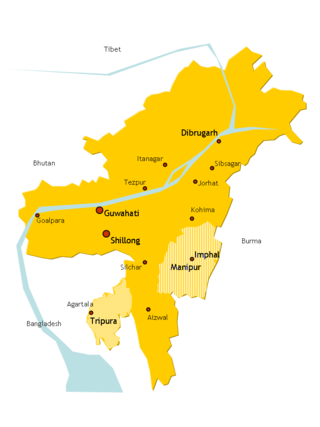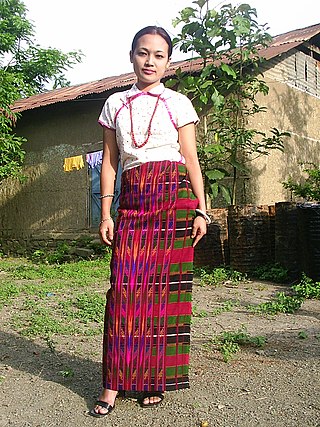Hmar people are a scheduled tribe ethnic group from the states of Manipur, Mizoram, Assam, and Meghalaya in Northeast India. They use the Hmar language as their primary language.
The Hmar language belongs to the Mizo language branch of the Sino-Tibetan family of languages. The speakers of this language use Mizo language as their second language (L2).

The Mizo people, historically recorded as the Lushais, are an ethnic group native to the state of Mizoram in India and neighbouring states of Northeast India. They speak the Tibeto-Burman language of Mizo, the official language and lingua franca of Mizoram. The state is the second most literate state in India, at more than a rate of 90%.
The Paite people are an ethnic group in Northeast India, mainly living in Manipur and Mizoram. The Paites are recognized as a scheduled tribe in these two states. They are part of the Kuki-Zo people, but prefer to use the Zomi identity. "Guite" is a major clan of the Paite people.

The history of Mizoram encompasses the history of Mizoram which lies in the southernmost part of northeast India. It is a conglomerate history of several ethnic groups of Chin people who migrated from Chin State of Burma. But information of their patterns of westward migration are based on oral history and archaeological inferences, hence nothing definite can be said. The recorded history started relatively recently around the mid-19th century when the adjoining regions were occupied by the British monarchy. Following religious, political and cultural revolutions in the mid-20th century majority of the people agglomerated into a super tribe, Mizo. Hence the officially recognised settlement of the Mizos became Mizoram.

Jampui Hills is a part of the Mizo hills range located in the North Tripura district in the north eastern part of the Indian state of Tripura. The average altitude of the hill range is approximately 1000 metres above sea level.

The Zou people Is are an ethnic group, that is an indigenous community living along the frontier of India and Burma, they are a sub-group of the Kuki people/Zo people. In India, they live with and are similar in language and habits to the Thadou people and Paite and the Simte peoples. In Burma, the Zou are counted among the Chin people. They are a hill people, "Zou" may plainly means "Hills" denoting the Zous are "people of the hills" or "of the hills", and "Zou" has also a different meaning in Zou language that is "complete" or another word for it is "finish". But, the Zou people believed that they incepted the name 'Zou' from their forefather 'Zou' or 'Zo', believed to be the progenitor of the broad Chin-Kuki-Mizo people.
Hauzel is a clan found to be within the Paite group of the Zos Zomi tribe popularly known as Zomi and Mizo by different clans of the tribe particularly in Manipur and Mizoram areas, northeast of India. They are also found in the Chin State of Burma as a Tedim-Chin sub-clan. The Hauzel are mostly concentrated in Lamka, the second largest town of Manipur state, India and many of them are living in Mizoram. Hauzel are mostly highly educated and they are known for their education and general administration skills.
Zo is a Northern Kuki-Chin-Mizo language originating in western Burma and spoken also in Mizoram and Manipur in northeastern India.
Guite is the progenitor clan of Zomi people, also called Chin in Myanmar, Mizo, or Paite, or even Kuki in India. According to Zam, Nigui Guite is the elder brother of the ancestral fathers of the Thadou people, namely Thangpi, Sattawng, and Neirawng. This genealogy was recently inscribed on the tribal memorial stone at Bungmual, Lamka in the presence of each family-head of the three major clans, Doungel, Kipgen, and Haokip, on August 7, 2011. Some historians, like Shakespeare, assumed Lamlei was the Nigui Guite himself but the Guites themselves recounted Tuahciang, the father of Lamlei, as the son of Nigui Guite instead, in their social-religious rites. Regarding Guite as the born son of Songthu and his sister, Nemnep, it was the practice of ancient royalty to issue royal heir and also to keep their bloodline pure instead. Depending on local pronunciation, the clan was also called by different names such as Nguite or Vuite, Gwite, Nwite, Paihte by the Lushei. In accord with the claim of their solar origin, the Guite clan has been called nampi, meaning noble or major or even dominant people, of the region in local dialect in the past.
The Lai people mainly inhabit the southern parts of Chin Hills in Myanmar's Chin State, in the townships of Falam, Thantlang and Hakha. They are also found in the Lawngtlai district of Mizoram, India, where they have been granted the Lai Autonomous District Council. Outside this area they are scattered in Mizoram and in Manipur. Their languages "Laizo Lai" and "Hakha Lai" are classified as Central Kuki-Chin languages.

Zogam known as Zoland, Zoram, Lushai Hills, Kuki Hills, lies in the northwest corner of the Mainland Southeast Asia landmass. This is the traditional ancestry homeland of the Zo people or Zomi who lived in this area before the colonial period under British rulership.
The Kuki-Chin languages are a branch of the Sino-Tibetan language family spoken in northeastern India, western Myanmar and southeastern Bangladesh. Most notable Kuki-Chin-speaking ethnic groups are referred to collectively as the Zo people which includes: the Mizo of Mizoram, the Kuki of Manipur, Assam, Nagaland, Tripura and Bangladesh and the Chin of Chin State, Myanmar.

The Zomi Revolutionary Army (ZRA) is an armed Zomi nationalist militant group formed in 1997, following an increase in ethnic tensions between the Kuki people and the Paites tribe in Churachandpur district of Manipur, India. Its parent organisation, the Zomi Re-unification Organisation, was founded in April 1993.
The Zo people is a term to denote the ethnolinguistically related speakers of the Kuki-Chin languages who primarily inhabit northeastern India, western Myanmar, and southeastern Bangladesh.
Vaiphei is a Sino-Tibetan language belonging to the Kuki-Chin linguistic subbranch of the Tibeto-Burman group of languages. It is spoken mainly in the Myanmar minutely in Manipur-KukiZogam, Mizoram, Assam, Meghalaya, and Tripura. The dialect spoken in Myanmar exhibits a least partial mutual intelligibility with the other Mizo/Kukish dialects of the area including Thadou, Hmar, Paite, Simte, Kom and Gangte languages.
The Zomi people are one of the main groups of the Zo (Kuki-Chin-Mizo) tribes. They live in mostly the India–Myanmar border, as well as in Bangladesh. The Zomi encompasses the various tribes like Paite and Chin, and the Zomi tribe that is called Chin is the Tiddim/Tedim. They call themselves Zomi and they speak their own language. The Zomi language is basically the language of the Tedim/Tiddim and is related to the Paite language.

The Neihsial is an ethnic group found in northeastern India and parts of Myanmar. Members of this group are largely concentrated in the Churachandpur, Senapati, Chandel District and Tamenglong district of the Indian state of Manipur. There is also a sizable population in the neighboring Chin State of Myanmar.
Varte is a surname of a clan under the Hmar tribe of Northeast India especially in the states of Mizoram, Manipur and Assam. However, the surname "Varte" is not limited to the Hmar tribe as people with the same surname are also found among the Paite tribe with slight variation in pronunciation and spelling where the 'r' is spelt and pronounced as 'l'. Also, the surname appears to be used by some people other than Hmar or Paite tribe. Notable among these people is Rosy Varte (1923–2012), a French actress who was of Armenian descent. The surname may have little or no connection to the Sanskrit "Vartee" or "Varte" which means "Sovereign King".
The culture of the Mizo people has been heavily influenced by Christianity. Mizo culture is rooted in the arts and ways of life of Mizos in India, Bangladesh and Myanmar







